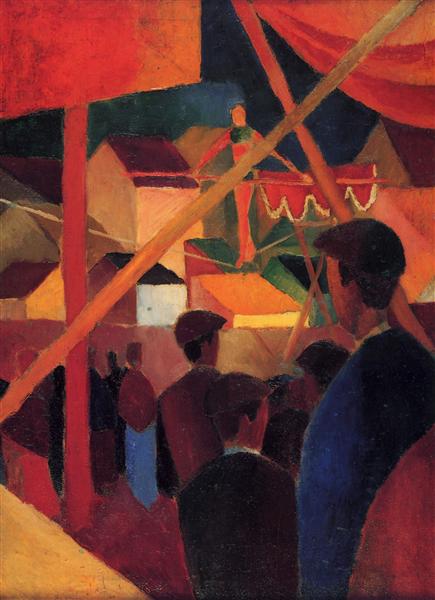Description
The "balanced" work of August Macke, created in 1914, is an emblematic piece that distills the essence of German expressionism, an artistic movement that sought to represent internal emotions and experiences through color and shape. Macke, one of the most prominent exponents of this style, uses his ability to combine symbolism and exuberance of color, creating a work that is both vibrant and introspective.
In the nucleus of the painting is the central figure of the balancer, which stands out for its bold possession and the lightness with which it walks on the rope. This figure not only represents an act of physical skill, but also a metaphor for the search for balance in life. The representation of the balancer, with his colorful clothing and his posture, evokes a sense of movement and dynamism, a characteristic feature of Macke's work. The tension between the figure and the background underlines the challenge it faces, encapsulating a duality between stability and risk.
The color palette used in "balancer" is a central appearance that deserves attention. Macke uses bright and saturated tones that communicate a vital energy. Intense yellow, deep blue and vibrant reds not only generate a visual effect that captures the viewer's attention, but also encourage an atmosphere of joy and emotion. This use of color is in line with the philosophy of expressionism, which intended to go beyond realistic representation, looking for an emotional and intuitive connection with the observer.
The background of the work is equally significant. With its abstract and almost dreamlike design, a space is inferred that, although it is not clearly defined, suggests movement and transformation. The intricate developments and fluid forms surrounding the balancer seem to reflect the instability of their act. This relationship between the figure and the environment emphasizes a constant struggle between the dominance of balance and the uncertainty of danger.
The context in which Macke created this work adds another layer of meaning. In 1914, Europe was in a situation of political and emotional instability that would soon culminate in World War I. The figure of the equilibriator can be interpreted as a symbol of the fragility of peace and harmony, a reminder that the delicate balance of life can break into an instant. In Macke's works, there is a clear intention to capture the essence of human experience, and this painting is no exception.
When observing "balancer", it is impossible not to relate it to other works by Macke and his contemporaries. The unique ability of the artist to combine the human element with a vibrant atmosphere reminds other expressionist works that also explored the human condition through form and color. However, Macke's originality lies in his particular approach, which integrates both the joy of the show and the underlying tension of existence.
In conclusion, "balancer" is much more than a visual representation of a circus act; It is a meditation on the balance, happiness and fragility of life itself. Through its exceptional use of color and shape, August Macke manages to capture a deep experience that resonates in the viewer, establishing a dialogue between art and life that remains relevant today. This work is erected as a will on the ability of art to reflect our internal struggles and the constant need to find our own balance.
KUADROS ©, a famous paint on your wall.
Hand-made oil painting reproductions, with the quality of professional artists and the distinctive seal of KUADROS ©.
Art reproduction service with satisfaction guarantee. If you are not completely satisfied with the replica of your painting, we refund your money 100%.

